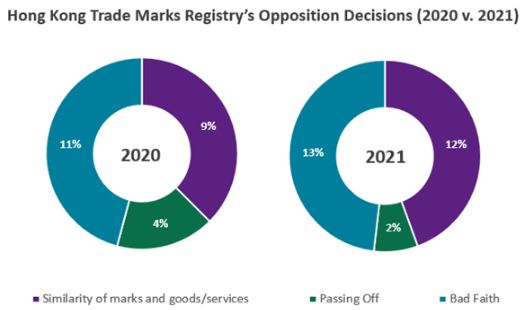- within Privacy topic(s)
- with readers working within the Retail & Leisure industries
The article highlights the grounds most used in opposition proceedings in Hong Kong in the last two years.
Legal grounds for a trade mark opposition
The Trade Marks Ordinance, Cap. 559 of the laws of Hong Kong ("the Ordinance"), categorises the opposition under absolute grounds and/or relative grounds which can be conferred through Sections 11 and 12 of the Ordinance. Some of the most commonly used grounds are:
1. Deceiving the public
According to Section 11(4)(b) of the Ordinance, if the applicant's mark is such that it is likely to deceive the public by making them believe that the concerned product or service belongs to the opponent's brand, then such trade mark is liable to be rejected on the face of it.
2. Bad Faith
According to Section 11(5)(b) of the Ordinance, no applicant is allowed to register any trade mark in bad faith. If any trade mark is filed for registration in bad faith, it is liable to be rejected out rightly.
3. Similarities of marks and goods/services and Well-known Trade mark
As per Section 12(3) and/or 12(4), a well-known mark of the opponent which pre-exists in the market should be protected and any identical or similar mark should be barred from registration.
4. Law of passing off
According to Section 12(5)(a) of the Ordinance, an unregistered trade mark is also protected under the common law action of passing off. Therefore, when an infringement of an unregistered trade mark eventuates, it is the law of passing off that applies to such an infringement.
Apart from the above there are other grounds that are also used frequently. They would include the absolute ground objections such as the mark is descriptive, non-distinctive, contrary to accepted principles of morality etc. However, as per the findings of the Trade mark Registry's opposition decisions of 2020 and 2021, it has been observed that the majority of the oppositions filed, the bad faith ground seems to have the highest chances of success. This opposition ground is followed by the claims of similarity between the marks and/or goods or services and the passing off ground.
To prove bad faith, it becomes immensely important for the opponent to highlight the facts that show the existence of bad faith of the applicant when filing the trade mark application. Some of the features that the Courts have observed in bad faith cases include:
- the opposed mark is identical or very similar to the opponent's mark;
- the applicant and opponent had a previous relationship (e.g. the applicant is or was a distributor);
- the applicant had knowledge of the opponent's mark or would have known of the opponent's mark due to for (e.g. the fame of the opponent and /or the applicant and opponent are in the same industry); and
- the applicant is a trade mark squatter.
In most oppositions, the relative ground (i.e. similarity of marks and goods/services) is the most commonly relied on in oppositions. If the opponent does not have an earlier trade mark registration in Hong Kong, it is possible to rely on the bad faith ground, passing off ground and the ground that the opponent's mark a well-known mark. For the passing off ground and the ground that the opponent's mark is a well-known, the opponent has a high burden of proof and needs to submit substantial amount of evidence. For the bad faith ground, the burden is not as high as the passing off and well-known mark grounds but must be specially pleaded. If the Applicant and Opponent had a prior relationship or the marks are identical, it would be easier to succeed on the bad faith ground.
Tackling bad faith opposition
While the Ordinance has granted the power to the opponents to raise an opposition based on bad faith, it does not indicate that it has to be raised in every case irrespective of the fact that it is nothing more than a perceived similarity between the earlier mark and the mark in question. This advances concerns regarding fairness towards the applicant's reputation. However, in a recent Trade Marks Registry's decision of Infinitus Intellectual Property Limited v. LKK Healthcare Products Group Limited, it has been clarified that the bad faith ground has to be pleaded carefully and not recklessly to retain discipline and fairness in the entire procedure of registration.
The concept of bad faith has not been defined in the Ordinance but in case law, it has been interpreted with 'dishonesty' and also some dealings which fall short of the standards of acceptable commercial behaviour observed by reasonable and experienced men in the particular area being examined. The subjective element of the test means that the tribunal must ascertain what the defendant knew about the transaction or other matters in question. It must then be decided whether, in the light of that knowledge, the defendant's conduct is dishonest being judged by ordinary standards of honest people.
Success rates
On review of the Hong Kong Trade Marks Registry's opposition decisions the success rates of the various opposition grounds in 2020 and 2021 are as follows:

These statistics demonstrate that the bad faith grounds had the highest percentage of success, followed by the ground of similarity of marks and goods/services.
Conclusion
The above insight on the various grounds of opposition is not unexpected. Amongst all the opposition grounds, one must keep in mind that the enforceability of the same, requires all the checkboxes of conditions to be ticked by the opponent backed by cogent evidence. No doubt the aforementioned grounds are the most used in Hong Kong, but significant considerations have to be given to the genuineness of such allegations. Failure to observe the same, the allegation will be thrown under the bus even before it makes its way to be entertained by the tribunal. Therefore, for a successful opposition, the opponent must make allegations that satisfy all the criteria along with cogent evidence.
The content of this article is intended to provide a general guide to the subject matter. Specialist advice should be sought about your specific circumstances.


